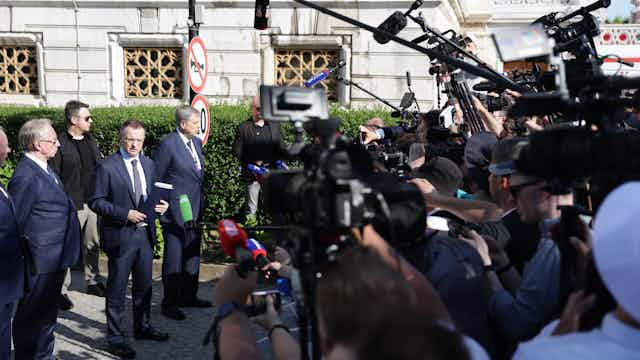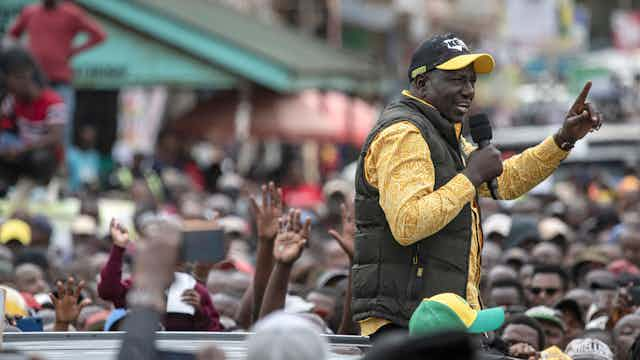Ukraine’s Innovative Drone Strike Misses Impact at Peace Talks as Conflict Stalemate Continues
Following the remarkable “spiderweb” mass drone assault on Russian air bases on June 1, delegates gathered the next day for another round of direct negotiations between Russia and Ukraine in Istanbul. This attack seems to have been a masterstroke of Ukrainian intelligence and organization, leading to the destruction or damage of billions of pounds worth of Russian aircraft positioned at bases throughout the nation, even extending to areas as distant as Siberia.
Ukrainian drone strikes, similar to Russia’s escalating air campaign, do not demonstrate a genuine commitment to negotiations from either side. At the recent talks, little of significance was agreed upon beyond a prisoner swap, reaffirming that neither a ceasefire nor a peace agreement is likely in the near future.
The wider context of battlefield developments offers vital insights into the forthcoming trajectory of the war. An earlier meeting in Istanbul in May saw Moscow and Kyiv agree to draft and exchange detailed proposals for a settlement. The Ukrainian proposal reiterated the long-standing position that any compromises on national sovereignty and territorial integrity are unacceptable.
In essence, Kyiv’s stance is that a Russian-imposed neutrality, which would preclude NATO membership and restrict the size of Ukraine’s armed forces, is not negotiable. Additionally, any form of international acknowledgment of Moscow’s illegal territorial acquisitions since 2014, including the annexation of Crimea, is off the table.
Kyiv’s proposal calls for an immediate ceasefire along the frontline as the “starting point for negotiations.” Discussions regarding territorial disputes would only take place “after a full and unconditional ceasefire.” This aligns closely with the peace plan presented by Ukrainian President Volodymyr Zelensky in late 2022, which gained positive feedback from primary western allies but failed to resonate broadly in the international community.
On the other hand, Russia’s proposals remain largely unchanged, insisting on full recognition of its territorial claims since 2014 and the imposition of Ukrainian neutrality. These stringent demands from Russia offer little in the way of genuine negotiation for Ukraine. The Kremlin’s terms feel more akin to a demand for surrender.
Ukraine, however, is firmly opposed to surrender. The recent drone attack on Russia’s strategic bomber fleet has provided a significant boost to Ukrainian morale. Yet, similar to earlier drone strikes against Moscow, this does not indicate that Ukraine possesses the sustained capability to counterbalance Russia’s manpower and equipment advantages.
Closer to the frontlines, Ukrainian forces struck electrical infrastructure in Russian-occupied areas of Zaporizhzhia and Kherson, potentially hindering any Russian plans for expansion in those regions. However, akin to the recent drone assaults, such operations primarily reinforce the existing stalemate rather than break it.
The conflict puts Ukraine under intense military pressure from Russia along the extensive frontline of over 1,000 miles, while the country remains vulnerable to aerial attacks. Although Russia may continue making minor incremental gains, significant breakthroughs or the collapse of Ukrainian defenses do not seem imminent.
Internationally, Ukraine’s position could be bolstered by a new bill in the US Senate proposing a 500% tariff on nations purchasing Russian resources, primarily targeting India and China. These nations are major consumers of Russian oil and gas, and should they prioritize trade with the US over inexpensive Russian imports, it could severely impact Russia’s revenue.
However, given former President Donald Trump’s indecisiveness regarding meaningful pressure on Vladimir Putin, the actual impact of the proposed legislation remains uncertain. With over 80 bipartisan co-sponsors in the Senate, it carries potential to override a presidential veto. But any delays in enforcing tougher sanctions may ultimately benefit Putin.
Contrastingly, European support for Ukraine has strengthened recently. For instance, EU leaders adopted their seventeenth sanctions package against Russia on May 20, and shortly after, Germany and Ukraine announced a new military cooperation agreement valued at €5 billion (£4.2 billion).
While this assistance falls short of what Kyiv needs for a substantial shift in battlefield dynamics, it is sufficient to prevent Russia from achieving military dominance, ensuring that Moscow’s current settlement proposals would not represent the only way for Ukraine to survive as an independent nation.
The war remains in deadlock, as neither Moscow nor Kyiv seems capable of escalating military operations to compel significant concessions from the other. Both sides are biding their time, hoping for improved circumstances. For Ukraine, this entails greater US military support and increased sanctions against Russia, while Europe continues to enhance its own and Ukraine’s defenses.
Russia, on the other hand, must maintain the loyalty of its remaining allies—China, Iran, and North Korea—while attempting to negotiate with Trump, a prospect that may prove challenging. In such a scenario, Putin’s best hope may hinge on Trump refraining from imposing substantial sanctions on Russia or its trade partners, not to mention ramping up military aid for Ukraine.
For both parties, much still depends on Washington’s approach. The unpredictability of the Trump administration, coupled with the cautious strategy under Biden, makes it unlikely for the war in Ukraine to progress beyond its current stalemate. This dynamic has become a significant roadblock, allowing both Moscow and Kyiv to harbor dreams of victory in a conflict that appears increasingly unwinnable.






